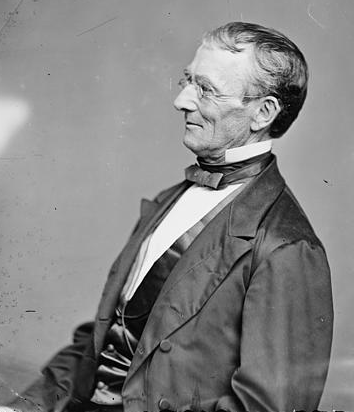
the February 7, 2019 cover of the New York Post highlighted when there was the potential to replace the top three officials in Virginia
Source: New York Post, New York Post

the February 7, 2019 cover of the New York Post highlighted when there was the potential to replace the top three officials in Virginia
Source: New York Post, New York Post
Five offices in Virginia are elected in statewide voting. Two offices are for seats in the US Senate.
There is no provision for voters to recalling Virginia's US Senators, or for the General Assembly to impeach and remove Federal officials from office, before their terms expire. In the US Constitution, Article I, Section 5 authorizes the US Senate to expel its elected members. That has happened once for Virginia.
In 1861, Virginia's two senators were expelled as the Civil War began. Senators James M. Mason and Robert M. T. Hunter withdrew on March 28, 1861, and attended no further meetings. Along with eight other senators, they were "striken from the rolls, and their seats declared vacant" on July 11, 1861.
Two replacement senators were elected by the legislature of the Restored Government of Virginia based in Wheeling. Waitman T. Willey and John S. Carlile were seated in the US Senate on July 13, 1861. Waitman was chosen to complete Mason's term through the 37th Congress, ending in March 1863. Carlile was elected to complete Hunter's term through March 3, 1865.
When West Virginia was accepted into the Union 1863, the new state's legislature chose two senators while the Restored Government of Virginia moved to Alexandria. Waitman T. Willey's term as a US Senator from Virginia had expired, and he was elected to the US Senate from West Virginia. The Restored Government of Virginia elected Lemuel J. Bowden as his replacement.
The US Senate accepted Bowden's credentials and he began serving in 1863, together with John S. Carlile. Bowden died in 1864, and the General Assembly of the Restored Government of Virginia chose a replacement. On February 17, 1865, at the end of the 38th Congress, the US Senate refused to allow Joseph Segar to serve in place of Bowden.
Carlile's term ended in 1865. On March 9, 1865, at the start of the 39th Congress, the US Senate refused to seat his replacement, John Underwood. Joseph Segar was excluded again. The spoken concern was the legitimacy of the Virginia General Assembly, but the politics of Reconstruction were a key factor. The Republican-controlled US Congress was not in a hurry to allow Southern states to regain voting privileges as if the Civil War had not occurred. The status quo ante bellum would not be restored without consequences for secession.
Between 1867-1870, Virginia was designated as Military District #1 and not treated as a separate state within the Union. After the state legislature ratified the Fourteenth and Fifteenth amendments to the U.S. Constitution and voters approved a new state constitution in 1869, Virginia was readmitted to the Union in January 1870. John F. Lewis was elected to a six-year term, and John W. Johnston was chosen to serve the remainder of the term which expired on March 3, 1871.1

Joseph Segar was excluded from the US Senate in 1865, along with John Underwood
Source: Library of Congress, Segar, Hon. Joseph Eggleston Rep. of VA
If a US Senator resigns or dies in office, the governor of Virginia is authorized to appoint a replacement. The appointee will serve as US Senator until the next regularly-scheduled statewide general election, an event which occurs each November in Virginia. The person who wins the election then serves the remaining years of the six-year term in the US Senate.
However, if the vacancy occurs within 120 days of that date, the appointed Senator serves until the second general election. That extra year avoids creating a hurried process for nominating candidates and conducting a too-short campaign.2
The last US Senator to be appointed in Virginia was Harry Byrd, Jr. His father had been re-elected in 1964, but Harry Byrd Sr. retired in 1965 before completing his term due to ill health. Governor Albertis S. Harrison appointed the Senator's son as his replacement in 1965.
Harry Byrd, Jr. then won the Democratic nomination in 1966 in a close race. He was elected that fall to complete the remaining four years of his father's term. Senator Harry Byrd, Jr. was re-elected to a full six-year term in 1970 as an Independent, after choosing not to compete in the Democratic primary.3
Since Virginia adopted its first constitution in 1776, five elected governors have been replaced before their terms expired.
Three Virginia governors have resigned before completing their terms. John Tyler, Littleton Waller Tazewell, and Thomas Walker Gilmer left office prior to the Civil War.
In 1865, at the end of the Civil War, Confederate governor William "Extra Billy" Smith resigned after the Confederate armies had surrendered and the Union Army had occupied Virginia. Governor Francis Pierpont, elected as governor of the Restored Government of Virginia in 1864, served almost a complete four-year term even after the Commonwealth of Virginia became Military District One during Reconstruction. General John Schofield appointed Henry H. Wells as governor about two months before Pierpont's term expired in 1868.
Since 1868, every elected governor has served their entire four-year term. An attempt to assassinate Governor Almond on the grounds of the State Capitol failed on April 10, 1959. It was a time of high political stress, as court decisions forced desegregation of public schools. The governor abandoned the most extreme policies of Massive Resistance; the assassin was never identified.
Some Lieutenant Governors have run for governor and been elected to full 4-year terms, but no Lieutenant Governor has become governor due to the death of the incumbent governor. The last Virginia governor to die during a term in office was George William Smith in 1811. He died before the 1850 constitution created the office of Lieutenant Governor, and allowed for the voters (rather than the legislature) to elect the governor and lieutenant governor.4
The current Constitution of Virginia (Article IV, Section 17) has provisions for the House of Delegates to impeach the Governor, Lieutenant Governor, and Attorney General. Judges, and all officers appointed by the Governor or elected by the General Assembly may also be impeached for "malfeasance in office, corruption, neglect of duty, or other high crime or misdemeanor."
If the House of Delegates votes by a majority to impeach an official, the a trial would be conducted by the State Senate. Removal from office would occur if approved by two-thirds of the senators present. If all 40 State Senators are present for the vote, then 27 of them must approve removal or the impeached official would stay in office.
"Impeachment" is only the start of the removal process for state officials, and is done by a vote in the House of Delegates. Impeachment triggers the equivalent of a trial by the State Senate. If two-thirds of the state senators present at the vote convict the impeached official, then they are removed from office and disqualified to hold "any office of honor, trust, or profit under the Commonwealth.5
No official in Virginia has been removed from office by the impeachment process, ever. In 2013, as Governor McDonnell was being investigated for illegal acceptance of gifts, one member of the House of Delegates called for impeachment. Others called for his resignation, which was a more-realistic option. The impeachment process would have required the governor to call for a special session of the General Assembly to consider removing him from office, or for 2/3 of the legislature to call for a special session.
Just weeks after Governor McDonnell completed his term, the US Department of Justice had him indicted on 13 felony charges. Former Governor McDonnell was convicted later that year on 11 counts and the decision was upheld by an appeals court, but in 2016 the US Supreme Court overturned the verdict. The US Supreme Court ruled that the lower courts' interpretation of "official acts" done in exchange for favors was too broad and vacated the convictions. That decision made former Governor McDonnell eligible to serve again in a state office of some sort.6
A serious impeachment possibility occurred in 2019. Lieutenant Governor Justin Fairfax was accused by two women of committing a sexual assault in 2000 and 2004. One member of the House of Delegates drafted an impeachment resolution, but in the end chose not to introduce it.7
The proposal occurred at a unique moment. Governor Ralph Northam had fumbled his response to the revelation that his medical school yearbook page included a picture of a man dressed in "blackface," which was associated with minstrels who had caricatured and mocked black people. The governor indicated at one point that he was that person in blackface, which intensified the storm of criticism about racial insensitivity.
Politicians from his own Democratic party, included the previous governor who had helped Northam get elected in 2017, called for the governor's resignation. If Governor Northam had resigned, Lieutenant Governor Fairfax would have replaced him.

elected Democrats in Virginia called for fellow Democrat Governor Northam to resign in February, 2019
Source: US Senator Mark Warner
That potential triggered the two women to go public with their statements about previous sexual assault by Justin Fairfax. Since the actins reportedly occurred years before he was elected, there were questions regarding whether they qualified as "malfeasance in office, corruption, neglect of duty, or other high crime or misdemeanor."
Soon after Governor Northam's photos were publicized, Attorney General Mark Herring announced that he too had once dressed in blackface while in college. The "bonfire of scandals" led to unprecedented calls for resignation by all three of the top state officials.
None chose to resign. The Republican majority in the House of Delegates made tentative steps towards impeachment hearings regarding one office, when it proposed to hold hearings where the accusers of Lieutenant Governor Fairfax could testify formally.8
A governor can notify the leaders in the General Assembly that he or she will be temporarily unable to serve, and the Lieutenant Governor will act as governor until the person elected as governor reclaims the position. The provision could be used by a governor undergoing a medical procedure where they would be temporarily disabled, but no one has invoked it since it was added to the constitution in 1971.
If the governor dies, resigns, or is removed from office, under the state constitution the Lieutenant Governor automatically becomes governor.9
If the Lieutenant Governor dies in office or becomes Governor, the rules of the Senate declare that the President pro tempore in the State Senate becomes the presiding officer of that legislative body. The "President pro tem" is traditionally the longest-serving member of the majority party in that chamber.
If Lieutenant Governor Fairfax had resigned in 2019, partisan power would have switched because the Republican Party had gained a majority of State Senate seats in the 2015 election. Fairfax was a Democrat, but his duties for presiding over the State Senate would have been assumed by the Republican serving as President pro tem.
A former Attorney General, Ken Cuccinelli, noted that "assuming the duties" was not equivalent to assuming the office and becoming the Lieutenant Governor. Cuccinelli also noted that the President pro tem would wear two hats:10
If a Lieutenant Governor resigns or dies in office, then the Governor could appoint a new Lieutenant Governor. That has never happened, but the state constitution establishes that the appointee's term would last only until a new Lieutenant Governor is chosen in the next general election:11
If Governor Northam had resigned right after the revelation of the picture of a man in blackface (and another wearing a Ku Klux Klan hood) on his 1984 medical school yearbook page, then Lieutenant Governor Fairfax would have become governor for the remainder of the term ending January 15, 2022. Governor Fairfax would have appointed a new Lieutenant Governor.12
If that had happened, Governor Fairfax could have run for a full four-year term as governor in November, 2021. The state constitution prohibits governors from serving two consecutive terms, but someone who fills the office through the succession process may run after that term ends and be elected for a full term.13
If Governor Northam had resigned and then Governor Fairfax had resigned before appointing a new Lieutenant Governor, then Attorney General Mark Herring would have become governor. He was not in a position to become Lieutenant Governor, however.
The Attorney General is not designated as an automatic successor to the office of Lieutenant Governor, and few Attorneys General would see that as a promotion. The full-time Attorney General position has government authority and political influence at least equivalent to, if not greater than, the part-time position of Lieutenant Governor.
If an Attorney General resigns or dies in office, the replacement process depends upon the timing of the vacancy:14
If Governor Northam, Lieutenant Governor Justin Fairfax, and Attorney General Mark Herring had all resigned quickly in 2019 with no replacements appointed, then Speaker of the House Kirk Cox would have become governor as fourth in line of succession. If for some reason the Speaker of the House does not qualify for office, then the House of Delegates would elected a replacement governor.
In 2019, the scandals tainting the top three officials occurred while the General Assembly was in session. If, if all three had resigned over the dramatic weekend when the news broke regarding use of blackface and the sexual assault allegations, then Speaker of the House Kirk Cox would have become governor. He could have then appointed a Republican to serve as Lieutenant Governor, replacing the Democratic Lieutenant Governor who had resigned.
Speaker Cox's seat would have been left vacant until after a new election for the 66th District. That still would have left the House of Delegates in Republican control, by a 50-49 majority. If the Attorney General had resigned, then the General Assembly would have elected a new person to that office. Since there would have been 69 Republicans and 68 Democrats in the General Assembly, a Republican could have been elected as the new Attorney General.
The succession process is defined in the current state constitution, which was adopted in 1971. The assassination of President Kennedy in 1963 and the threat of "decapitation" of government leadership in a nuclear war had spurred concerns about an orderly succession to elected offices and adoption of the 25th Amendment to the US Constitution. The 1971 state constitution states:15
In 2019, the Speaker of the House, Kirk Cox, was a Republican with a significantly more conservative philosophy than the three Democrats who had been elected statewide in 2017.
The 2017 election had been a "blue wave," with the Democrats replacing 15 Republicans in the House of Delegates and coming within a hair of creating a 50-50 tie in that chamber. Total votes for one House of Delegates seat actually ended in a tie, which the Virginia State Board of Elections broke by picking the name of one candidate out of a bowl. The Republican candidate was chosen by chance, so the Republican party ended up with a 51-49 majority and Kirk Cox became Speaker of the House of Delegates.
The constitutional process that would have made him governor, had Governor Northam, Lieutenant Governor Justin Fairfax, and Attorney General Mark Herring resigned, would have produced a dramatic shift in political power without an election. In the nightmare scenario that the Democrats feared might occur in February, 2019, the three statewide offices would have switched from Democrats to Republicans. The new incumbents would have stayed in office until January 15, 2022.
In the end, all three chose to stay in office. Over a year later, investigators hired by Eastern Virginia Medical School concluded that they could not identify the person on Dr. Northam's 1984 medical school yearbook page who was dressed in blackface. The inconclusive report allowed Republican opponents to continue to label him "Gov. Blackface."16
The state constitution includes a second mechanism for removing the governor, in addition to impeachment. That provision has never been invoked, yet:17
The governor can dispute the claim that he or she is disabled. If there is a contest, the General Assembly has the final authority. Unless 75 members of the House of Delegates and 30 members of the State Senate declare the governor is still disqualified, the person elected as governor will assume the office again.
There is the potential that the Governor, Lieutenant Governor, and Attorney General will not be able to serve and House of Delegates would be unable to convene, presumably after a major disaster or enemy attack. The state constitution includes a predetermined sequence in which an Acting Governor would assume office - the Speaker of the House, the person he has designated to act in his place, the President pro tempore of the Senate, and finally the majority leader of the Senate. They would serve only until the House of Delegates could meet and elect a governor.18
That line of succession reflects the perception that the House of Delegates is more responsive to voter priorities than the State Senate, due to the shorter terms. All members in the 100-member House of Delegates are elected every two years, while the 40 members in the State Senate serve four-year terms.